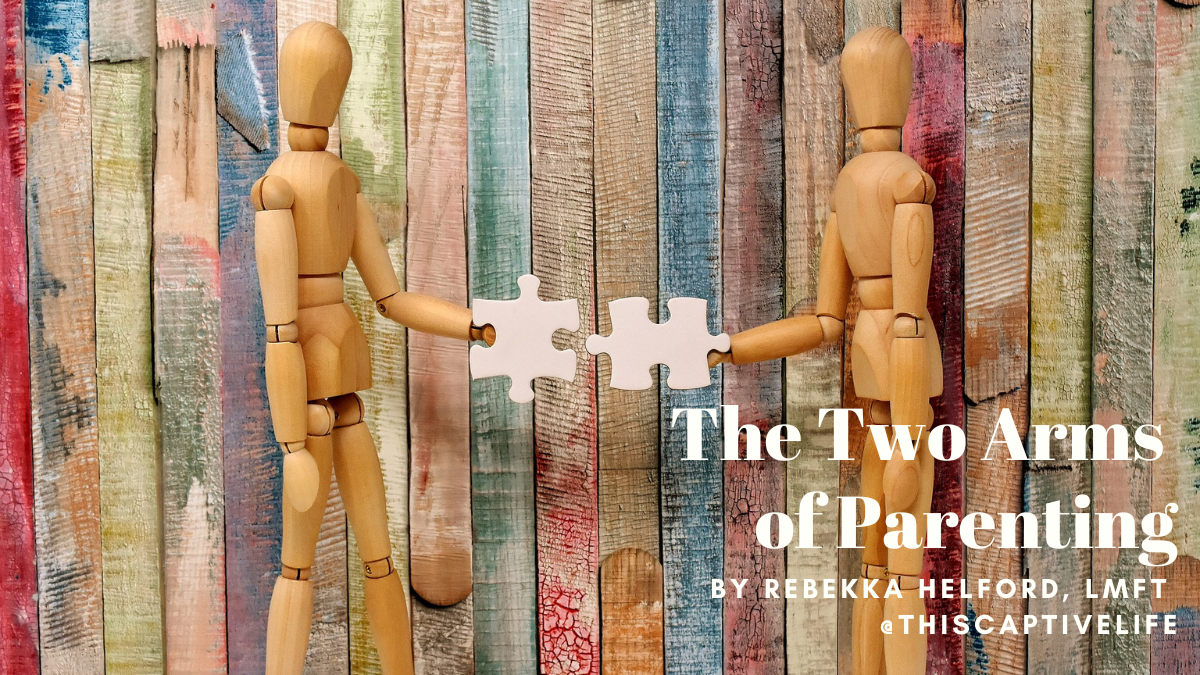The two arms of parenting
Author’s note: Every once in a while, we encounter an idea so powerful, so simple, and so true that it has an irrevocable effect on nearly all of our thoughts. About 10 years ago, I was privileged to glean one such idea from my colleague and friend Diane Reynolds, LMFT, to whom proper attribution and credit is due. With her permission, I have presented my interpretation of that idea herein.
As a parent (or, indeed, as a therapist, friend, or partner), we have two arms. These two arms remind us of our two main tasks in approaching our loved ones and their many complex needs.
With one arm, we hold the feelings. With the other, we hold the line.
When we hold feelings, this means we acknowledge, validate, and make space for whatever feeling the other person is experiencing. Big or small, challenging or joyful, comfortable or uncomfortable.
Here are some things we might say when we hold a child’s feelings:
”I hear you. You don’t like that it’s bedtime.”
”I saw you fall down - you got scared. I’ll hold you until you feel better.”
”I see - you can put on your shoes all by yourself! You are so proud!”
When we hold the line, it means we set a limit or boundary. We can do this for a number of reasons - safety, health, convenience, and willingness are some top candidates. When we hold the line, we do so calmly yet firmly, presenting the limit as a fact or merely as information to be shared.
Here are some things we might say when we hold the line with a child:
”It’s time to go to bed - it’s not time to keep playing.” (Health-related boundary)
”We use crayons on paper. You may not draw on the wall.” (Convenience-related boundary)
”Mommies and daddies use knives. Children do not use knives.” (Safety-related boundary)
”I’m not up for reading that book again - we’ve read it lots of times. Let’s choose another one.” (Willingness-related boundary)
When we hold both feelings and the line, we are being authoritative parents. We are being gentle but firm, kind but fair.
As two-armed parents, we know that in addition to their other big feelings, children will have feelings about the limits we set! Children don’t have to be grateful for our limits. They don’t have to like them. And we will serve the relationship enormously well if, as we set those limits that they dislike and for which they are ungrateful, we show that we get their disapproval.
Here are some things we might say when we hold both the feelings and the line with a child:
”I hear you. You don’t like that it’s bedtime. And it’s still time to go to bed. I know, you wish you could keep playing. And now it’s bedtime. Would you like to read this story or that one?”
”You really want to hold mommy’s lip balm. I can let you hold it while it’s closed, but not while it’s open. I hear you - you really want to hold it while it’s open, and I won’t let you do that. I know you don’t like it.”
When we use both arms, we treat others - children included, but all people really - with respect. Sometimes, when I describe my philosophy of respectful parenting, people think that I mean permissive parenting - that respecting a child’s feelings and intentions is synonymous with them having their way. As I hope I have made clear, this could not be farther from the truth. Yes, we must respect a child’s feelings and intentions. But we must also hold the line, because children desperately need boundaries and limits, set firmly and calmly by a kinder, wiser, stronger grown-up.
Feelings and boundaries can live together without cancelling each other out. After all, we have two arms: one to hold each.
Further reading on this topic:
Rebekka Helford is a licensed marriage and family therapist in private practice in Los Angeles, California. With over a decade of experience working with parents and young children, Rebekka specializes in short-term intensive parenting consultation, using a variety of tools including home, office, and school visits to help families navigate developmental hiccups and get back on track. Virtual visits now available!
Click here to schedule an appointment or contact Rebekka with a question – who knows, she might even answer it in her next post!


